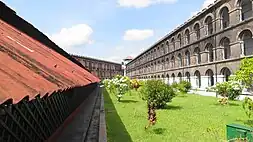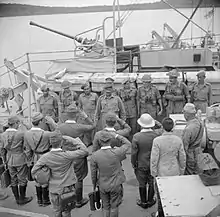The Andaman and Nicobar Islands is an archipelago of 572 islands of which 37 are inhabited. It is a union territory of India.
First inhabitants
The earliest archaeological evidence documents some 2,210 years ago. However, genetic and cultural studies suggest that the indigenous Andamanese people may have been isolated from other populations during the Middle Paleolithic, which ended 30,000 years ago.[1] that time, the Andamanese have diversified into linguistically and culturally distinct, territorial groups.
The Nicobar Islands appear to have been populated by people of various backgrounds. By the time of European contact, the indigenous inhabitants had coalesced into the Nicobarese people, speaking multiple Mon-Khmer languages; and the Shompen, whose language is of uncertain affiliation. Both are unrelated to the Andamanese, but being closely related to the Austroasiatic languages in mainland Southeast Asia.
Chola empire period
Rajendra I, used the Andaman and Nicobar Islands as a strategic naval base to launch an expedition against the Sriwijaya Empire (Indonesia). The Cholas called the island Ma-Nakkavaram ("great open/naked land"), found in the Thanjavur inscription of 1050 AD. European traveller Marco Polo (12th–13th century) also referred to this island as 'Necuverann' and a corrupted form of the Tamil name Nakkavaram would have led to the modern name Nicobar during the British colonial period.[2]
Danish colonial period and British rule
The history of organised European colonisation on the islands began when settlers from the Danish East India Company arrived in the Nicobar Islands on 12 December 1755. On 1 January 1756, the Nicobar Islands were made a Danish colony, first named New Denmark,[3] and later (December 1756) Frederick's Islands (Frederiksøerne). During 1754–1756 they were administered from Tranquebar (in continental Danish India). The islands were repeatedly abandoned due to outbreaks of malaria between 14 April 1759 and 19 August 1768, from 1787 to 1807/05, 1814 to 1831, 1830 to 1834 and gradually from 1848 for good.[3]
.jpg.webp)
From 1 June 1778 to 1784, Austria mistakenly assumed that Denmark had abandoned its claims to the Nicobar Islands and attempted to establish a colony on them,[4] renaming them Theresia Islands.[3]
In 1789 the British set up a naval base and penal colony on Chatham Island next to Great Andaman, where now lies the town of Port Blair. Two years later the colony was moved to Port Cornwallis on Great Andaman, but it was abandoned in 1796 due to disease.
Denmark's presence in the territory ended formally on 16 October 1868 when it sold the rights to the Nicobar Islands to Britain,[4] which made them part of British India in 1869.

In 1858 the British again established a colony at Port Blair, which proved to be more permanent. The primary purpose was to set up a penal colony for criminal convicts from the Indian subcontinent. The colony came to include the infamous Cellular Jail.
In 1872 the Andaman and Nicobar islands were united under a single chief commissioner at Port Blair.
World War II
During World War II, the islands were practically under Japanese control, only nominally under the authority of the Arzi Hukumate Azad Hind of Subhash Chandra Bose. Bose visited the islands during the war, and renamed them as "Shaheed-dweep" (Martyr Island) and "Swaraj-dweep" (Self-rule Island).

General Loganathan, of the Indian National Army was made the Governor of the Andaman and Nicobar Islands. On 22 February 1944 he along with four INA officers—Major Mansoor Ali Alvi, Sub. Lt. Md. Iqbal, Lt. Suba Singh and stenographer Srinivasan—arrived at Lambaline Airport in Port Blair. On 21 March 1944 the Headquarters of the Civil Administration was established near the Gurudwara at Aberdeen Bazaar. On 2 October 1944, Col. Loganathan handed over the charge to Maj. Alvi and left Port Blair, never to return.[5]
Japanese Vice Admiral Hara Teizo, and Major-General Tamenori Sato surrendered the islands to Brigadier J A Salomons, commander of 116th Indian Infantry Brigade, and Chief Administrator Mr Noel K Patterson, Indian Civil Service, on 7 October 1945, in a ceremony performed on the Gymkhana Ground, Port Blair.
Post-Independence (1947 CE – present)
During the independence of both India (1947) and Burma (1948), the departing British announced their intention to resettle all Anglo-Indians and Anglo-Burmese on these islands to form their own nation, although this never materialized. It became part of India in 1950 and was declared as a union territory of the nation in 1956.[6]
India has been developing defense facilities on the islands since the 1980s. The islands now have a key position in India's strategic role in the Bay of Bengal and the Malacca Strait.[7]
2004 Asian tsunami
On 26 December 2004, the coasts of the Andaman and Nicobar Islands were devastated by a 10 m (33 ft) massive tsunami following the undersea earthquake off Indian Ocean. More than 2,000 people lost their lives, more than 4,000 children were orphaned or suffered the loss of one parent, and a minimum of 40,000 people were rendered homeless. More than 46,000 people were injured.[8] The worst affected Nicobar islands were Katchal and Indira Point; the latter subsided 4.25 metres (13.9 feet) and was partially submerged in the ocean. The lighthouse at Indira Point was damaged but has been repaired since then. The territory lost a large amount of area which is now submerged. The territory which was at Indian states 8,073 km2 (3,117 sq mi) is now at 7,950 km2 (3,070 sq mi).[9]
While locals and tourist of the islands suffered the greatest casualties from the tsunami, most of the aboriginal people survived because oral traditions passed down from generations ago warned them to evacuate from large waves that follow large earthquakes.[10]
References
Notes
Citations
- ↑ Palanichamy, Malliya G.; Agrawal, Suraksha; Yao, Yong-Gang; Kong, Qing-Peng; Sun, Chang; Khan, Faisal; Chaudhuri, Tapas Kumar; Zhang, Ya-Ping (2006). "Comment on 'Reconstructing the Origin of Andaman Islanders'". Science. 311 (5760): 470. doi:10.1126/science.1120176. PMID 16439647.
- ↑ Government of India (1908). The Andaman and Nicobar Islands: Local Gazetteer. Superintendent of Government Printing, Calcutta.
... In the great Tanjore inscription of 1050 AD, the Andamans are mentioned under a translated name along with the Nicobars, as Nakkavaram or land of the naked people.
- 1 2 3 ben cahoon. "Provinces of British India". Worldstatesmen.org. Retrieved 2013-07-08.
- 1 2 Ramerini, Marco. "Chronology of Danish Colonial Settlements". ColonialVoyage.com. Archived from the original on 4 April 2005. Retrieved 16 November 2010.
- ↑ Roychowdhury, Rabin. "Black Days in Andaman and Nicobar Islands", Manas, New Delhi.
- ↑ Planning Commission of India (2008). Andaman and Nicobar Islands Development Report. State Development Report series (illustrated ed.). Academic Foundation. ISBN 978-81-7188-652-4. Retrieved 12 March 2011.
- ↑ David Brewster. "India's Defence Strategy and the India-ASEAN Relationship. Retrieved 24 August 2014".
- ↑ Carl Strand and John Masek, ed. (2007). Sumatra-Andaman Islands Earthquake and Tsunami of December 6, 2004: Lifeline Performance. Reston, VA: ASCE, Technical Council on Lifeline Earthquake Engineering. ISBN 9780784409510. Archived from the original on 24 October 2013.
- ↑ Effect of the 2004 Indian Ocean earthquake on India
- ↑ "Tsunami folklore 'saved islanders'". BBC News. 20 January 2005. Retrieved 23 April 2010.